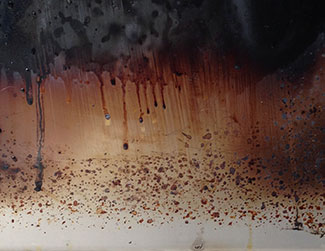| g e n u i n e i d e a s | ||||||
 |
 |
 |
 |
 |
 |
 |
| home | art and science |
writings | biography | food | inventions | search |
| electric fuel | ||
|
||
|
May 2014 Summary of electricity as a barbecue fuel:
Electricity is the most recent, and arguably the most convenient, heat source. Simply plug a smoker into any outlet and electricity courses through a resistance element until it glows dull red. Some smokers even lack an on-off switch! Depending on your utility company, the primary electrical generator might be fueled by coal, natural gas, water, wind, solar or nuclear. The electric element heats the surrounding air and the food cooks. A standard electric element glows dull red - e.g. around 1000F. Basically, you are smoking with a space heater. This is too low a temperature to break air apart chemically, so it will not generate CO/NO. Thus a "smoke ring" is a rare beast in an electric. Good thing, too. Otherwise your electric range would trip the carbon monoxide detector, and your kitchen would smell of unburned organic molecules whenever boiling water on the stove.
The flavor issue is easily resolved- most electric smokers are designed with a tray that holds wood chips or sawdust. The electric heater causes the wood to smolder and then catch fire. In the end, wood combustion flavors your meat. Alternatively, the tray catches grease drippings, singes the grease, and this aromatic plume coats the meat1. Another limitation of electric smokers is power. Plugging the cord into a standard 120V 20 amp circuit limits the power to 120V*20A=2400W. For safety, most electric smokers are designed to operate from 500W to 1500W. This way your extension cord won't melt and catch fire. Many high quality electric smokers are well insulated, like a kitchen oven, to make the best use of their limited heat capacity. Few operate about 250F. This low power rating has two consequences. First, very little air moves through the smoker, because cold fresh air has to be heated, and the element is pretty wimpy. Its easy to calculate the upper limit to air flow2- around 1-2 complete air exchanges a minute in say, a Brinkman, though actually closer to 10 per hour. This low air flow greatly distorts wood chip combustion (see wood fuel article), and the wood will not optimally combust from a flavor perspective. Instead of burning at 1600F as in an offset smoker, wood hunks in an electric smolder between 400F and 900F.
This low temperature favors creosote formation, and you may quickly discover the walls of the smoker are covered with a dark orange varnish. The low temperature and lack of oxygen also prevents ammonia (NH3) in the combustion stream from oxidizing into nitric oxide. So no smoke ring. The second consequence of low air flow is generally high humidity. Any moisture evaporating from the cooking meat, or from a water pan, is trapped by the low air flow. This moisture will help the meat's collagen breakdown, which is good, but also shifts the wood chip gas profile away from NO. And thus away from generating a smoke ring. So electrics trade convenience and tenderness off against bark and flavor. But they are a great choice to use on an apartment patio, or if you want to cook a brisket for 16 hours overnight without once having to get up to tend the fire. Considering that many people ruin a perfectly nice charcoal briquette fire by starving the fuel for oxygen, or by covering the meat with sooty ashes, an electric looks pretty good by comparison. Even an electric smoker will beat most BBQ restaurants hands down.
|
||
|
1 Singed grease contains a variety of acids, alcohols, oxidized fats, VOCs and carcinogens such as PAH. Interestingly, smoke from all cooking sources (primarily home kitchens and commercial restaurants where fat is singing on hot surfaces) is responsible for 15% to 20% of the total particle air pollution in major cities like LA. 2 To calculate how much energy it takes to heat up a substance, you multiply the mass of the substance times the heat capacity times the temperature rise. The heat capacity of air is around 1000 Joules/ kg-C. Since air's density is around 1.2 kg/m3, this means a m3 of air has a heat capacity of 1200 J/C. About six Brinkmans would fit in a cubic meter, so the air heat capacity per Brinkman is around 200 J/C. Of the 1500Ws of heat generated by the electric element, 80% is lost through the thin steel walls. So only 1500W*.2=300 watts is available to heat the air by around 100C (from 50F to 250F). This means you need 100C*200 J/C=20,000J to heat every Brinkman air volume. Since there is only 300W available to heat the air, it will take 20,000J/300W=66 secs. If you imagine how quickly a space heater could warm up a cylinder the size of a Brinkman, these estimates are about right. In other words, a typical electric smoker might exchange its full volume of air once every few minutes. My experiments on two electric smokers measured 6-10 exchanges an hour, which is 10x lower than a gas grill. Which is why electric smokers are often more humid. Of course, a smart electric smoker design would be double-walled, and draw in fresh air through the plenum created by the wall offset. Some wood stoves/chimneys use this technique. The gap basically forms a heat-exchanger that pre-heats cool combustion gas against the hot inner-wall, so less power is required from the electrical elements. Which could be traded off against higher oxygen flow, a more intense fire, and perhaps a smoke ring.
|
||
Contact Greg Blonder by email here - Modified Genuine Ideas, LLC. |

